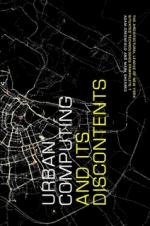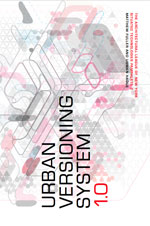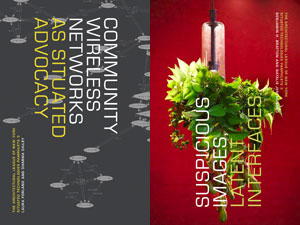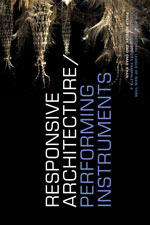Joseph Nechvatal: Immersive Ideals / Critical Distances. A Study of the Affinity Between Artistic Ideologies Based in Virtual Reality and Previous Immersive Idioms (1999)
Filed under thesis | Tags: · aesthetics, architecture, art history, immersion, philosophy of art, technology, virtual reality
This thesis researches into the ideals behind Virtual Reality technology (and its central property of total-immersion) by looking at VR through the prism of a philosophy of visual art. Its conclusive understanding is achieved through a broad formulation of an aesthetic theory of immersive consciousness (indicative of an emerging immersive culture) by joining choice immersive examples of simulacra technology into mental connections with relevant examples culled from the histories of art, architecture, information-technology, sex, myth, space, consciousness and philosophy.
Keywords: architecture| Conceptual Art | consciousness | information-technology | myth | sex | space | virtual reality
Written in candidacy for a Ph.D. at the Centre for Advanced Inquiry in the Interactive Arts (CAiiA), University of Wales College, Newport, Wales, U. K.
More info
Later published as a book (2009)
William W Braham, Jonathan A Hale (eds.): Rethinking Technology: A Reader in Architectural Theory (2006)
Filed under book | Tags: · architecture, city, design, technology, theory

“This book contains over fifty selected essays, manifestoes, reflections and theories by architects and architectural writers from 1900 to 2004. This mapping out of a century of architectural technology reveals the discipline’s long and close attention to the experience and effects of new technologies, and provides a broad picture of the shift from the ‘age of tools’ to the ‘age of systems’.
Chronological arrangement and cross-referencing of the articles enable both a thematic and historically contextual understanding of the topic and highlight important thematic connections across time.”
Publisher Routledge, 2006
ISBN 0415346541, 9780415346542
488 pages
PDF, PDF (updated on 2018-5-31)
Comments (2)The Situated Technologies Pamphlets 1-4 (2007-2009)
Filed under pamphlet | Tags: · architecture, city, interactive design, labour, life, situated technologies, ubiquitous computing, urban computing, urbanism
The Situated Technologies Pamphlet Series extends a discourse initiated in the summer of 2006 by a three-month-long discussion on the Institute for Distributed Creativity (iDC) mailing list, which culminated in the Architecture and Situated Technologies symposium at the Urban Center and Eyebeam in New York that October, co-produced by the Center for Virtual Architecture, the Architectural League of New York, and the iDC.
The series aims to explore the implications of ubiquitous computing for architecture and urbanism: How are our experience of the city and the choices we make in it affected by mobile communications, pervasive media, ambient informatics, and other “situated” technologies? How will the ability to design increasingly responsive environments alter the ways we conceive of space? What do architects need to know about urban computing, and what do technologists need to know about cities? How are these issues themselves situated within larger social, cultural, environmental, and political concerns?
Published three times a year over three years, the series is structured as a succession of nine “conversations” between researchers, writers and other practitioners of architecture, art, philosophy of technology, comparative media study, performance studies, and engineering. It takes on the urgent and ambitious task of exploring the implications of emerging technologies and their intersection with daily life.
Such a rapid insertion of texts into discourse is rarely witnessed within the context of traditional US publishing, which often requires years to go from manuscript to distribution of the printed book. We feel strongly that the discussion about Situated Technologies cannot be postponed that long. At the same time, we acknowledge that the subject is itself a moving target, as these technologies continue to evolve rapidly. Given these considerations, we’ve opted to publish the series using Print On Demand (POD) technology. Widely used but still little known, this publishing technique allows fast turnaround of books that can be ordered through online bookstores and are indistinguishable from many books in your bookshelf.
Series Editors: Omar Khan, Trebor Scholz, Mark Shepard

Situated Technologies Pamphlet 1: Urban Computing and its Discontents
by Adam Greenfield and Mark Shepard
Fall 2007
A conversation between the authors providing an overview of the key issues, historical precedents, and contemporary approaches to designing situated technologies and inhabiting cities populated by them.
Download a PDF here or get a printed copy from Lulu.com.

Situated Technologies Pamphlet 2: Urban Versioning System 1.0
by Matthew Fuller and Usman Haque
Spring 2008
What lessons can architecture learn from software development, and more specifically, from the Free, Libre, and Open Source Software (FLOSS) movement? Written in the form of a quasi-license, Urban Versioning System 1.0 posits seven constraints that, if followed, will contribute to an open source urbanism that radically challenges the conventional ways in which cities are constructed.
Download a PDF here or get a printed copy from Lulu.com.

Situated Technologies Pamphlet 3: Situated Advocacy
Summer 2008
A special double issue featuring the essays:
Community Wireless Networks as Situated Advocacy
– Laura Forlano and Dharma Dailey
Suspicious Images, Latent Interfaces
– Benjamin Bratton and Natalie Jeremijenko
Advocacy is the act of arguing on behalf of a particular cause, idea or person, and addresses issues including self-advocacy, environmental protection, the rights of women, youth and minorities, social justice, the re-structured digital divide and political reform.
Situated Technologies Pamphlets 3: Situated Advocacy considers how situated technologies have been—or might be—mobilized toward changing and/or influencing social or political policies, practices, and beliefs. What new forms of advocacy are enabled by contemporary location-based or context-aware media and information systems? How might they lend tactical support to the process of managing information flows and disseminating strategic knowledge that influences individual behavior or opinion, corporate conduct or public policy and law?
Download a PDF here or get a printed copy from Lulu.com.

Situated Technologies Pamphlet 4: Responsive Architecture / Performing Instruments
by Philip Beesley and Omar Khan
Spring 2009
A new generation of architecture that responds to building occupants and environmental factors has embraced distributed technical systems as a means and end for developing more mutually enriching relationships between people, the space they inhabit, and the environment. This pamphlet discusses key qualities of “responsive” architecture as a performing instrument that is both mutable and contestable.
Download a PDF here or get a printed copy from Lulu.com.
Comment (0)
